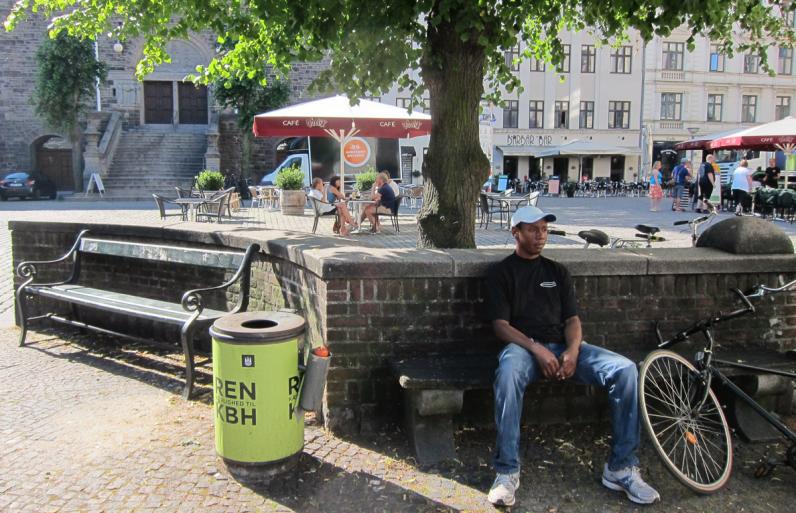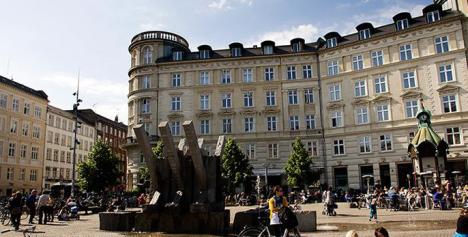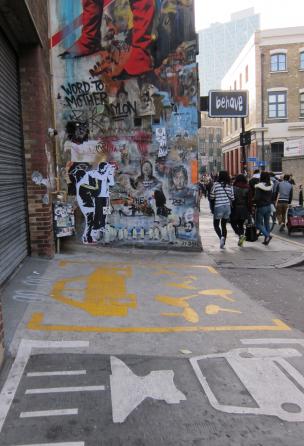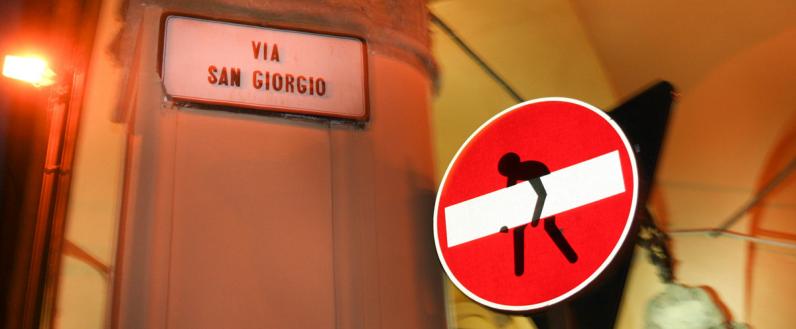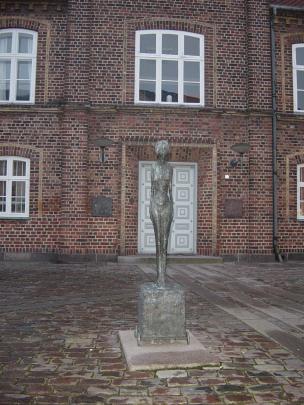
PUBLIC SPACE AS A SITE
A public space can be a square, a bus stop, a park or the roads we travel on when we go from one place to another. These are places where we travel freely without thinking about it. And where we are in no doubt that we are in the public domain. But what about a school, a hospital or city hall? Or the gym in the local shopping center? These places can also be defined as public spaces, even though they are actually privately owned. The essential factor is that the space, in principle, is accessible to everyone, even if you have to pay an entrance fee. But in practice, they are not necessarily accessible to everyone. You are not allowed to go freely around government ministries, hospitals and schools or stay in them. You go to such places when you have a reason to. Neither is it considered appropriate for homeless persons to settle in certain spots in the public space for very long at a time. That a space is public in principle does not necessarily mean that in practice it is accessible to everyone at all times or that everyone considers it accessible. Many people would not consider a place where you must pay an entrance fee – such as a museum – to be a public space, even if it is a state museum and thus, in principle, belongs to all of us. On the other hand, many people probably see shopping centers as part of the public domain, even though they are privately owned.
As a place, the public sphere is thus difficult to define. There are many – on the face of it, rather diverse – types of public space. That there is something called the public space in the definite form is therefore actually misleading. Public space is the public, physical space that we all move around in, with all the qualifications that might apply. It is also an abstract concept that encompasses the sphere in which we agree that we can express ourselves.
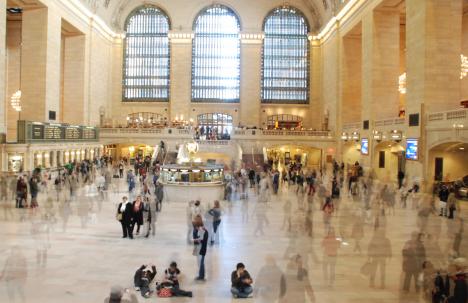 A busy railway station in New York.
A busy railway station in New York.
A single “public opinion”?
Another type of public space that receives much attention is the Internet and the media – TV, newspapers and radio. We “meet” here every day, although not physically. People’s opinions also come forth here and are shared with the rest of the population in a less concrete public forum.
All the people who have access to public space and the opportunity to express themselves do not have the same opinions, so the public space is also a place for disagreements and differences. That public spaces are shared is not a guarantee of unity and a sense of community.
When something is public, in principle all of us have a part of it – it is a common concern. We all have the right to move around in the public domain, and therefore we also share responsibility for it. But when something belongs to everyone, it can easily become no one’s. Certainly not everyone feels their local town meeting hall is their shared space. Or a highway in a distant part of the country, for example. Nevertheless, one speaks of “public opinion”.
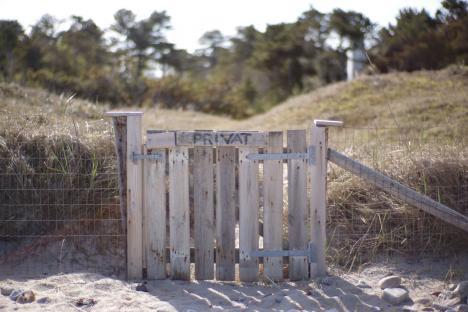 A clear demarcation that separates a public space from a private one.
A clear demarcation that separates a public space from a private one.
Photo: Isabel Aagaard
Christiania
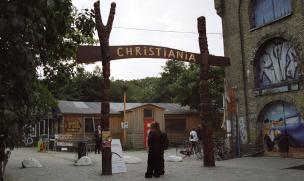 The entrance to Christiania clearly shows that we are moving from one part of the city to another. Photo: Bruno Jargot (Wikimedia Commons)In some cases, a group of people has taken over a public space and made it their own in practice. The obvious example in Denmark is Christiania, which a group of people formed in 1971 in a public area. The occupied area has become a village in the midst of the city. Today, about a thousand people live in Christiania, and it is a tourist attraction with thousands of visitors a day. After many years of uncertainty and disagreement about the future of Christiania, an agreement was reached in 2011 that enabled the “Christianites” (the residents) to buy Christiania through the Christiania Foundation. You could say that something that had been public actually became private. But the money for the purchase was collected partly by the sale of so-called “people’s shares”, which in principle made the place once again a shared entity. And Christiania will still be open and publicly accessible, even though certainly not everyone feels welcome or at home there.
The entrance to Christiania clearly shows that we are moving from one part of the city to another. Photo: Bruno Jargot (Wikimedia Commons)In some cases, a group of people has taken over a public space and made it their own in practice. The obvious example in Denmark is Christiania, which a group of people formed in 1971 in a public area. The occupied area has become a village in the midst of the city. Today, about a thousand people live in Christiania, and it is a tourist attraction with thousands of visitors a day. After many years of uncertainty and disagreement about the future of Christiania, an agreement was reached in 2011 that enabled the “Christianites” (the residents) to buy Christiania through the Christiania Foundation. You could say that something that had been public actually became private. But the money for the purchase was collected partly by the sale of so-called “people’s shares”, which in principle made the place once again a shared entity. And Christiania will still be open and publicly accessible, even though certainly not everyone feels welcome or at home there.
The private out in the public
The boundary between private and public is blurred in today’s media landscape. On TV programs, private matters such as buying a house, furnishing a home, sex, child rearing and substance abuse are displayed and discussed in public. Private conversations take place in public spaces, so – while we ride a train or wait for a bus on the way to school or work – we get a glimpse into the lives of others. And Facebook, which many still consider private, is also a place where people can easily keep track of others’ private lives. The public sphere is thus many things, and it is difficult to determine where the boundary between public and private lies.
When public space is a place for art
Museums provide a setting for many encounters with art and culture. With the criticism of the institution in mind, however, you could argue that a special kind of audience goes to museums and that museums themselves also cater to a special audience. The discussion about art in public spaces often concerns the fact that it exists in a place where we are already. Art in public spaces is not just about seeking out spaces other than museums; it is also about seeking out a different audience, a different public, that perhaps does not go to museums.
“According to the practice in urban environments, art in public spaces serves to create meanings, uses and forms for the city. In this capacity, it can help to obtain consent for the renovation and restructuring that represents the historical form of late capitalist urbanization. But like other institutions, [...] it can also call into question and resist these types of activity and thus reveal the apparent contradictions in the urban process.”
Rosalyn Deutsche, art historian
A decoration of a gable, a design for a shared area inside or outside, and a sculpture in a square are examples of art in public spaces. But it can also be a temporary installation or performance. Or posters that are an almost unnoticed part of the street scene. There are thus many different types of art in public spaces, and many approaches to what art in public spaces should “be able to do”. Should it primarily be decorative, be practical or create debate, for example? Or maybe even offer an alternative to the way things are today?
Art as stimulus for debate
“Denmark’s most expensive dog toilet.” “Disputed work of art should be removed.” “If only it was a tree.” “Send the work of art back.” The headlines refer to a work that the painter Øivind Nygård created at Mølle Square in Aalborg in 1992 in collaboration with the Danish Arts Foundation. As these headlines suggest, art in public spaces can create debate. After eight years, the work was moved. Unlike Richard Serra’s Tilted Arc, which is discussed in the “When Art Gets in the Way” case, this work was placed in another location, the town’s art museum.
People differ, so there may be disagreements about what should take priority in spending on our shared space – this applies not only to infrastructure and hospitals but also to works of art. When art in public spaces provokes animated debate, it is often because some people are dissatisfied with the artwork that has been placed in “their” city’s space. The argument is often that a work of art has changed the space in a negative way that is not aesthetically pleasing, that it is provocative, or that it has cost too much money. And it is shared money – public funds. Removing a sculpture can also be costly, however.
Comments in the street scene
Some forms of art in public spaces that serve as a direct commentary on the urban scene are considered street art. Paste-ups, stencils, murals and modified road signs can be found in many of the world’s large cities. They often comment on the current situation or make a satirical contribution to the cityscape. Street art is often defined as an illegal artistic expression in urban space as opposed to the more monumental artistic projects in public spaces such as municipalities erect in cooperation with the Danish Arts Foundation, for example, or private foundations. Street art is also perceived as something that lies outside the established art scene. Ironically, several street artists have become famous – despite their anonymity. The artist Husk Mit Navn (Remember My Name), for example, has had many gallery exhibitions. Banksy, the British street artist, has become so famous that his unauthorized paste-ups and stencils with critical comments on shopfronts are no longer seen as graffiti and removed but are protected by Plexiglas and are considered works worthy of preservation. While a generally illegal artistic practice in public spaces in some cases can win favor, at other times the opposite may be the case – that more well-established art is not welcome.
It has become more and more common for art in public spaces to consist of temporary projects rather than permanent sculptures. The debate that a work may occasion in this case is short-lived – for better or worse. If a work is not popular, you can take comfort in the fact that it will soon be gone. On the other hand, it can be annoying that a good initiative disappears.
In some cases, initial skepticism about a public sculpture changes to approval. In 1966, when Alberto Giacometti’s sculpture Woman on Cart was set up in Holstebro, Denmark, there were large protests that the municipality had spent so much money on a sculpture. Despite the protests, the sculpture remained, and now it is a work that most people in the town are proud of. After the sculpture soared in value, the town now treats it very carefully, lowering it into the ground in an elevator shaft every evening at 9 and raising it again at 9 in the morning.
Involving citizens
Who knows what is most appropriate for a specific site? Those who use the place daily or those with professional insight? Upon the installation of a work at the Great Square in Aarhus, Denmark, there was great frustration because the proposals of six artists were not presented to the public or put to a vote. When the choice fell to Elisabeth Toubro’s sculpture Torvenes båndsløjfe (The Bow of the Squares), it did not arouse enthusiasm. The sculpture acquired the nickname The Water Dragon, and it still stands at the site despite protests.
In cases like Tilted Arc and the Toubro sculpture in Aarhus, citizens feel it is an assault on “their place” when a work that they are not interested in is “foisted” upon them. Although there is rarely much discussion of all the advertising that fills the public space without our requesting it, when it comes to public artwork, the discussion can become quite heated. The criticism is often that those who pay, for example the Danish Arts Foundation or the New Carlsberg Foundation, have great influence on what adorns public spaces throughout Denmark, while no one asks those who live in the area in question. The reply to this is to question whether the residents of a locality always know what they want when they do not know the options. And whether it is possible to create something interesting that everyone likes when we all differ from one another and have differing opinions and preferences. There is much to indicate that some works that end up being the most popular are those that have also challenged people’s ideas of what they wanted. This was shown in the “It’s Our Art” project, for instance (see the link below). The examples in which user participation has been found to work well are often projects in which the user group is relatively small. One instance is the Men’s Home on Istedgade street in Copenhagen, which the artists Kenneth Balfelt and FOS redesigned after holding a dialogue with employees and users. The needs, values and desires of everyone in the building were the clear basis for the work on a new design.
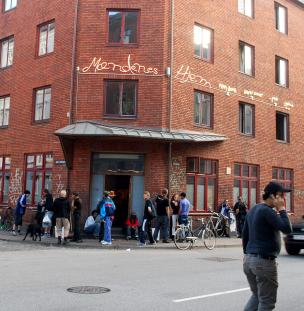 The Men’s Home on Istedgade, Copenhagen. Photo: Erik Christensen (Wikimedia Commons)
The Men’s Home on Istedgade, Copenhagen. Photo: Erik Christensen (Wikimedia Commons)
The presentation of art in public spaces
Art in public spaces is inherently difficult to maintain. It is often placed outside and not at an institution like a museum that has art as its main concern. That art in public spaces has an existence without as much attention as the artwork in museums is also a matter of presentation. Denmark has a museum of art in public spaces. It conducts research about art in public spaces and collects and exhibits sketches and models, among other things. But how does one present art that is situated in public spaces? Are the pedestrians at all interested in an art experience when they walk by? With digital media, it has become possible to disseminate knowledge at the places where you experience art, without its being forced upon those who are not interested. Websites and apps such as Art on Site/Our Art (National Arts Foundation) make available knowledge about works that you can seek out.
ACTIVITIES
Do something in a public space that you normally would do somewhere else. For example, you could take a brief nap, sing or put makeup on. Present your experiences in class.
Street artists use public spaces both to create and to exhibit their artwork. Street art has gradually become an established art form, and artists such as Husk Mit Navn (Remember My Name) and the British artist Banksy have also found their way into museums.
Go around the museum and find a work of art there that could go in the other direction: from the museum out into the public space. How should the work be rethought in order to function in the public space?
Tip for students: Much street art reaches its audience through documentation on the Internet. For example, you can find street artists at http://www.streetartutopia.com/ and http://www.streetheart.dk/ (in Danish)
Banksy has toyed with the theme of the museum as a place in his piece “Banksy in the Museum”, which can be seen on YouTube. You can also find films, for example by Blublu, an Italian who brings street art to life in fascinating animated films.
Take photographs of works of art in public spaces that you pass by every day.
Consider why the works are located where they are. Discuss the influence that the location can have on the perception of the works and the status they have. Could you do something to change their status?
Find works in the public space that
serve as a landmark or icon
provoke or create debate
are overlooked
Create a sketch or model for a work for which you take into account the location of the work and the reception you expect it would get.
Tip for students: It might be difficult to find works in all three categories in your area. You can therefore do this assignment either by seeking out physical works in public spaces or by finding them on the Web or in books.
Find a public space that you think is not working well and where you think an (artistic) intervention could make a positive difference. Create a proposal for how this place could be changed.
Visit the place to research it. Here are some helpful questions that you can ask yourself as you research the place:
What challenges are there in the place? Where is it? What materials are at the site, such as concrete, tiles, glass, wood, and so on? Are there trees, bushes and the like? Are there already artistic ornaments there? What is the closest neighbor? Who passes through the area? Is it primarily a place for pedestrians, cyclists or motorists, or is it deserted? Do people live nearby? Are there shops, cafés and other businesses? Can you sit down? How do you get to and from the place? What special characteristics are there that could be emphasized or should be toned down, for example water, the terrain and traffic? Take photographs of the site – both an overview and details. You could also record the sounds of the place.
Keep a log of your research and your considerations during your investigation. Make a model, collage, PowerPoint presentation or the like. Present both the finished project and the process to the class.
Teaching tip: Expand the assignment on creating changes in a public space by including it in a field trip. When visiting new places you have another way of looking at sites and maybe another viewpoint about what sites function well.
Teaching tip: Interdisciplinary work, for example with social studies: Hold interviews with or make questionnaires for the site’s daily users. Pose questions, for example about what they think functions well and what does not, what changes they would like, and so on. Such an assignment may also include considerations of various types of user and segmentation. What kind of user do you want to attract and to keep away with the changes you are proposing?
Teaching tip: Interdisciplinary work, with history: Dig into the history of the place. How was the site used in the past?












